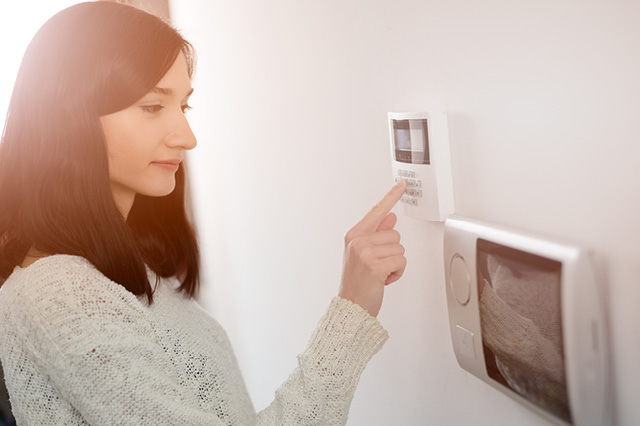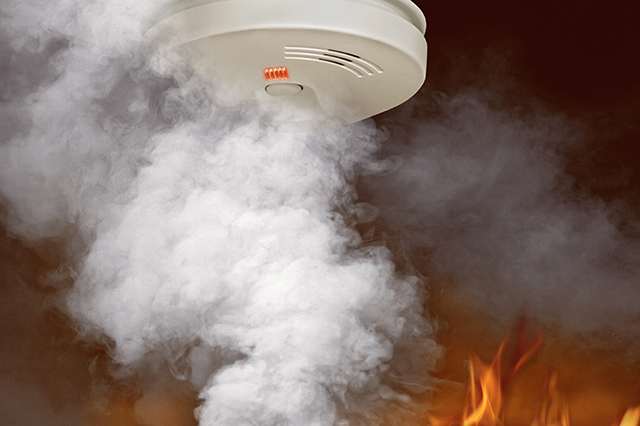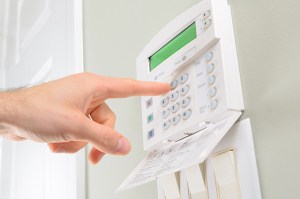Home safety starts with being alerted to potential problems as soon as possible. From carbon monoxide and house fires to burglaries, floods and other accidents, having the right detectors and alarms in place is a simple preventative measure that can save lives. Knowing about the types of detectors, where they should be installed and when to replace them are also key to your family’s safety at home.
Smoke Alarms
“Fire research has demonstrated that with today’s modern furnishings, fires can spread much more rapidly than in the past when more natural materials were used,” reports the National Fire Protection Association. “Because of this, having a sufficient number of properly located smoke alarms is essential.”
There are two common types of smoke alarms. Generally, ionization smoke alarms are more responsive to “flaming fires,” while photoelectric are more responsive to “smoldering fires,” according to the NFPA. Using a combination of both is highly recommended, although the type and number of smoke alarms required in homes is set by local law.
Smoke alarms are designed to detect the presence of smoke and alert people in the home of potential danger but must be connected to a monitoring service to signal the fire department, a service a professional alarm installer can provide.
Smoke alarms should be installed on every level of a home, including in the basement, as well as inside each bedroom and outside every sleeping area. To maintain your devices, try to test once a month, replace the batteries at least once a year and completely replace them every ten years.
There were 3,704 deaths and 16,600 injuries from fires in 2019, according to the latest statistics from the U.S. Fire Administration, and just over half of these were due to cooking. Having a smoke alarm near the oven is a good idea, but it should be at least 10 feet away to prevent setting it off every time you accidentally – or purposefully – char your food. Also, don’t put smoke alarms too close to a window or exterior doorway, as potential drafts could throw off its detection.
Shop for highly-rated smoke detectors on Amazon.
Carbon Monoxide Detectors
Carbon monoxide is a poisonous gas sometimes referred to as the “silent killer.” Unlike fire, with its flames, heat and smoky smell, CO is dangerous because it is invisible, odorless and tasteless.
“Each year, more than 400 Americans die from unintentional CO poisoning not linked to fires, more than 100,000 visit the emergency room and more than 14,000 are hospitalized,” says the Centers for Disease Conrtol and Prevention.
The symptoms of carbon monoxide poisoning are similar to those of the flu – dizziness, fatigue, headaches and nausea – and so many people disregard these warning signs. Long-term exposure to CO can lead to chest pain, confusion, irritability, impaired judgment and coordination, loss of consciousness and death.
The elderly and young children are especially susceptible to CO poisoning, as well as anyone with anemia, cardiovascular disease, sickle cell anemia or respiratory conditions.
Carbon monoxide is produced by many fuel-burning household appliances, like water heaters, furnaces or boilers, gas and wood-burning fireplaces and stoves. Other kinds of CO-emitting appliances, that can be hazardous if you use them indoors or too close to your home, include generators, grills, lawn equipment and power tools.
Since carbon monoxide is undetectable to our senses, CO sensors are absolutely necessary for home safety. You’ll want two to three carbon monoxide detectors in an average-sized home – more if your home is larger. Place detectors near heat-producing appliances, and replace them every five years. To make sure your detector is working efficiently, change its batteries once or twice a year.
To be safe, all fuel-burning appliances should vent outside. You should also have your heating system serviced once a year to make sure everything is working properly.
Shop for highly-rated carbon monoxide detectors on Amazon.

Flood Sensors
Flood sensors can detect unusual levels of moisture, helping to protect your home from potential water damage. Not only is water damage costly – flooding ruins carpet, furniture, electronics, etc. – it can also lead to mold.
If you live in an area that experiences flooding and/or heavy rains, a flood sensor can monitor places prone to water damage, like attics, basements and crawlspaces, and warn you about water seeping into your home.
If you live in a drier area, you may still want to consider flood sensors for potential indoor incidents, such as burst pipes during freezing temperatures, a leaking sink or washing machine, plumbing issues, etc.
“Just 1 inch of water can cause $25,000 of damage to your home,” according to FEMA’s National Flood Insurance Program. However, standard home insurance policies don’t protect against flood damage. If you are concerned about flooding, you should consider purchasing a separate flood insurance policy. Reach out to a AAA insurance agent to learn more.
Shop for highly-rated leak/flood detectors on Amazon.
Motion Detectors
Motion sensors are an important part of protecting your loved ones, your home and your valuables. Today’s security systems are capable of monitoring in real-time who’s ringing the doorbell, entering your home or even going into a specific room. Some systems even send notifications straight to your phone.
Motion detectors are great for combating burglaries. There are many types of motion detectors to choose from to fit your home and your needs. Some basics include passive infrared, microwave and video motion detectors as well as dual technology motion sensors that combine different methods of monitoring.
Pets are notorious for setting off motion alarms, but detectors that go by weight or are placed above your pet’s height are less likely to give false alarms.
Shop for highly-rated motion detectors on Amazon.
Detecting potential risks as soon as possible by using a variety of home safety detectors can help protect your family, pets and assets. Plus, most insurance companies provide a discount on homeowners insurance if there is a centrally monitored security system, which typically includes motion sensors and smoke detectors.
| Home Safety Detectors on Amazon | ||||
|---|---|---|---|---|
 | First Alert 9120B Smoke Detector, Hardwired Alarm with Battery Backup, 1-Pack | PrimeEligible | Buy Now | |
 | Kidde Smoke Detector, 9V Battery Operated Smoke Alarm, Test-Reset Button, Battery Included | PrimeEligible | Buy Now | |
 | Kidde Smoke & Carbon Monoxide Detector, AA Battery Powered, LED Warning Light Indicators | PrimeEligible | Buy Now | |
 | First Alert CO605 Plug-In Carbon Monoxide Detector with Battery Backup , White | PrimeEligible | Buy Now | |
 | Kidde Carbon Monoxide Detector, Plug In Wall with AA Battery Backup, Test-Hush Button | PrimeEligible | Buy Now | |
 | Govee Water Leak Detectors 5 Pack, 100dB Adjustable Audio Alarm Sensor, Sensitive Leak and Drip Alert, for Kitchen Bathroom Basement (Battery Included) | PrimeEligible | Buy Now | |
 | THE BASEMENT WATCHDOG Model BWD-HWA 110 dB Battery Operated Water Alarm | PrimeEligible | Buy Now | |
 | LaView Security Cameras 4pcs, Home Security Camera Indoor 1080P, Wi-Fi Cameras Wired for Pet, Motion Detection, Two-Way Audio, Night Vision, Phone App, Works with Alexa, iOS & Android & Web Access | PrimeEligible | Buy Now | |
 | ieGeek Floodlight Camera, Outdoor Home Security Camera, 2K Wired Flood Light Camera Outdoor with Motion Sensor Cam, 2600 Lumens,Color Night Vision,110dB Siren,2 Way Audio,Compatible with Alexa | PrimeEligible | Buy Now |
Make sure your home is protected with homeowners insurance from AAA.
This post contains several affiliate links. Products are not endorsed by AAA Northeast. When you make a purchase, AAA Northeast could receive revenue.
6 Thoughts on “Home Safety Detectors You Should Have”
Leave A Comment
Comments are subject to moderation and may or may not be published at the editor’s discretion. Only comments that are relevant to the article and add value to the Your AAA community will be considered. Comments may be edited for clarity and length.


















I found the first section confusing. Are smoke detectors and fire alarms the same thing? The author calls it “Smoke Detectors and Fire Alarms” as if they are distinct and then alternates from one to the other (with a few “smoke alarms” thrown in) with no explanation of what the difference is, if any.
I completely agree. I would say that they’re one in the same, like calling a cotton swab a Q-Tip or a bandage a Band-Aid. If someone wants to get technical, I guess they can call ionization alarms, fire alarms, and photoelectric alarms, smoke alarms. I’d prefer to buy a combo version and cover my bases. One important alarm missing is a natural gas alarm. I didn’t know they existed until the utility company found I had a gas leak behind my apartment wall, for possibly years. They plug into a wall, and would have saved me from months of inexplicable illness and potential explosion in my building.
I can’t stress enough about Carbonide alarms. I recently had an incident where the carbon monoxide levels were in the lethal levels and if it wasn’t for the censor I never would have realized the danger in my home.
Outside of a bedroom or inside doesn’t cut it. Some people sleep with the door open some closed. Thats problematic depending on where the fire is. Both are essential. If a smoke detector is to close any cooking device it becomes unless because of burnt toast etc. I put a 3 gas alarm between the gas boiler and gas dryer. They’re 10 feet apart in the cellar. All mine are battery powered, I chose the 10 year battery type because the sensor usable life is 10 years.
For faster detection of fire without false positives from smoke consider SaferAlarms. Their detectors send a signal to a sounder (alarm) in a safe place. Can be used in the kitchen, laundry room, above electrical outlets etc. They also have a sensor disguised as a Christmas tree ornament that can be placed right in the tree. If the ornament is destroyed by fire the sounder/alarm placed in a safe place where you can hear it continues to go off. Available on Amazon, WalMart.com, HomeDepot.com
It’s apparent that the writer just knows enough about smoke and CO alarms to be dangerous. What he says is basically true except he should have divided it into more specific items to consider such as (1) It is true about the two types of smoke alarms being the ionization and photoelectric but he failed to state that the homeowner needs to comply with the local building codes because many places specifically specify which one you can install. And he also fails to mention alarms used in the garages because the code might specify “Heat only” alarms. Plus he also fails to mention that most home smoke alarms are electrically wired and the battery is only used as a back-up when the home’s electrical power goes out. Basically a smoke alarm will run on the battery power for over a year when unplugged from the primary power source. He should have also mentioned that the home owner should use alkaline batteries for best performance.(2) He should have also mentioned that when you replace a smoke detector that he or she should replace with the same manufacturer’s models and NOT from another manufacturer because it might not be compatible with how the alarms talk with each other and you start getting false alarms. I could go on but this is enough for the average reader.